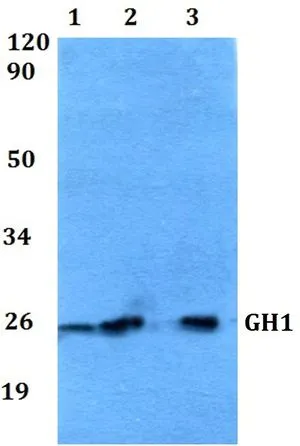![ELISA analysis of human growth hormone using GTX27905 Growth Hormone antibody [GH-45] compared with mouse IgG1 isotype control antibody MOPC-21. ELISA analysis of human growth hormone using GTX27905 Growth Hormone antibody [GH-45] compared with mouse IgG1 isotype control antibody MOPC-21.](https://www.genetex.com/upload/website/prouct_img/normal/GTX27905/GTX27905_20191028_ELISA_1_w_23060722_729.webp)
ELISA analysis of human growth hormone using GTX27905 Growth Hormone antibody [GH-45] compared with mouse IgG1 isotype control antibody MOPC-21.
Growth Hormone antibody [GH-45]
GTX27905
ApplicationsImmunoFluorescence, ELISA, ImmunoCytoChemistry, ImmunoHistoChemistry, ImmunoHistoChemistry Paraffin
Product group Antibodies
TargetGH1
Overview
- SupplierGeneTex
- Product NameGrowth Hormone antibody [GH-45]
- Delivery Days Customer9
- ApplicationsImmunoFluorescence, ELISA, ImmunoCytoChemistry, ImmunoHistoChemistry, ImmunoHistoChemistry Paraffin
- CertificationResearch Use Only
- ClonalityMonoclonal
- Clone IDGH-45
- Concentration0.5 mg/ml
- ConjugateUnconjugated
- Gene ID2688
- Target nameGH1
- Target descriptiongrowth hormone 1
- Target synonymsGH, GH-N, GHB5, GHN, IGHD1A, IGHD1B, IGHD2, hGH-N, somatotropin, growth hormone B5, pituitary growth hormone
- HostMouse
- IsotypeIgG1
- Protein IDP01241
- Protein NameSomatotropin
- Scientific DescriptionThe protein encoded by this gene is a member of the somatotropin/prolactin family of hormones which play an important role in growth control. The gene, along with four other related genes, is located at the growth hormone locus on chromosome 17 where they are interspersed in the same transcriptional orientation; an arrangement which is thought to have evolved by a series of gene duplications. The five genes share a remarkably high degree of sequence identity. Alternative splicing generates additional isoforms of each of the five growth hormones, leading to further diversity and potential for specialization. This particular family member is expressed in the pituitary but not in placental tissue as is the case for the other four genes in the growth hormone locus. Mutations in or deletions of the gene lead to growth hormone deficiency and short stature. [provided by RefSeq, Jul 2008]
- Storage Instruction2°C to 8°C
- UNSPSC12352203

![WB analysis of recombinant hGH and 20kDa hGH using Growth Hormone antibody [g3H5] at a dilution of 1:500.](https://www.genetex.com/upload/website/prouct_img/normal/GTX53723/GTX53723_WB_w_23060900_449.webp)

![IHC-P analysis of human pituitary tissue using GTX34768 Growth Hormone antibody [GH/1371].](https://www.genetex.com/upload/website/prouct_img/normal/GTX34768/GTX34768_20200115_IHC-P_951_w_23060801_534.webp)
![IHC-P analysis of human pituitary tissue using GTX34769 Growth Hormone antibody [GH/1450].](https://www.genetex.com/upload/website/prouct_img/normal/GTX34769/GTX34769_20200115_IHC-P_954_w_23060801_402.webp)
![IHC-P analysis of human pituitary tissue using GTX34770 Growth Hormone antibody [SPM106].](https://www.genetex.com/upload/website/prouct_img/normal/GTX34770/GTX34770_20200115_IHC-P_953_w_23060801_772.webp)